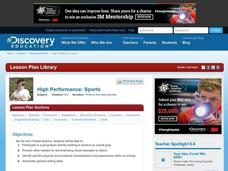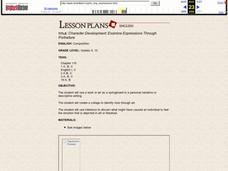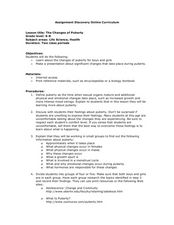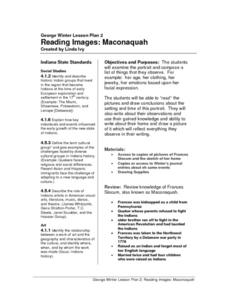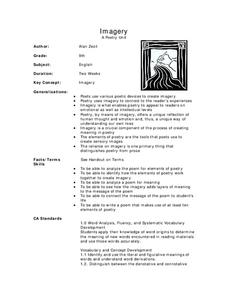Curated OER
You Have to Live in Somebody Else's Country to Understand
Students reflect on emotions commonly expressed by outsiders. They identify feelings of people who have just arrived in America. They read and analyze a poem about immigration.
Curated OER
Sports
Students identify specific physical and emotional characteristics and experiences within an activity. They work in small groups. Students are introduced to different everyday objects. In their groups they choose from the objects...
Alabama Learning Exchange
The Five Senses: How They Relate to our World
Students explore the five senses and the significance of each sense. In this five senses and diversity lesson, students listen to You Can't Smell a Flower With Your Ear by Joanna Cole and take a walk observing opportunities to use all...
Curated OER
Applying Principles of Civic Liberty
Third graders relate the everyday duties in the classroom and in the community. In this character education instructional activity, 3rd graders compare duties in the classroom to duties in the community and chart them on a Venn diagram....
Curated OER
Character Education: Honesty
Students explore traits of honest communication. In this character development and communication lesson, students are given 6 simple statements and work as a group to alter the meaning of each statement through body language, facial...
Curated OER
Defining Caring
Eighth graders define caring. In this character education lesson, 8th graders examine the attributes of compassion as they discuss altruism, empathy, and selflessness.
Curated OER
CHARACTER DEVELOPMENT: EXAMINE EXPRESSIONS THROUGH PORTRAITURE
Students use a work or art as a springboard to a personal narrative or descriptive writing, create a collage to identify tone through art, and use inference to discern what might have caused an individual to feel the emotion that is...
Curated OER
Personal Development (Child Abuse Prevention)
Students define several types of abuse, including sexual, physical, and emotional abuse or neglect. They recognize signs of abusive situations and describe the potential consequences of abuse
Curated OER
Using Words to Work Things Out
Students listen as teacher reads Words Are Not For Hurting, and answer questions about the content. Students discuss how to prevent arguments and work disagreements out with words. Students watch a puppet show that promotes discussion as...
Curated OER
Ribbon Wand Dancing
Pupils construct a ribbon wand which, through the use of line, color, contrast and shape can be used to better express a given emotion. Students improvise a brief dance created through manipulation of ribbon wand using three distinct...
Curated OER
Ribbon Wand Dancing
Students construct a ribbon wand which, through the use of line, color, contrast and shape can be used to better express a given emotion. They create a dance using the ribbon wand.
Curated OER
Three Part Dialogue
Eighth graders write a three part dialogue as part of an effective memoir. In this three part dialogue lesson, 8th graders are given two parts of a dialogue and emotions that accompany the words. Students then create the...
Curated OER
Follow the Leader: Line in the Visual Arts
Students identify line in the composition of a number of art works. They explain how the artist's compositional choices guide the viewer's eye to important components of the image. Students identify sight lines in several paintings and...
Curated OER
Friendship Begins with A Smile
Students examine the emotions behind different facial expressions. They explain how it feels when someone smiles at them and practice smiling and speaking to someone with eye contact. They also demonstrate the characteristics of active...
Curated OER
Amnesty: More Than a Word
Students explain how the use of certain emotive terms affects voter's perceptions. Students assess how word choice by political parties can changes our thinking on a subject. After viewing ads by the two political parties, students...
Curated OER
The Changes of Puberty
Students study about the changes of puberty for boys and girls. In this health instructional activity, students study how the body changes during puberty and make a presentation about a significant change that can take place during...
Curated OER
Abuse and Neglect
Students identify the types of child abuse, how it occurs, and how to report it. They listen to a guest speaker lecture on child abuse and how to prevent it.
Curated OER
Poetry: Serve Warmly and More Often
Students identify the mood and theme associated with the language of poetry. They discuss personal interpretation in small groups, and as a class and * experiment with language and rhythm.
Curated OER
Puberty
Students identify three physical and emotional changes boys and girls go through at puberty. They also discuss the difference in ages in which puberty occurs and complete worksheets.
Curated OER
From Korea to Vietnam: America Changes Her View on War
Eleventh graders identify and analyze the differences between the Korean and the Vietnam Wars. In small groups they conduct research and create a scene from a movie that focuses on the Korean or Vietnam War. Students view and evaluate...
Curated OER
Reading Images: Maconaquah
Students examine a portrait of Maconaquah and compose a list of things they observe about her. They look at her age, clothing, jewelry, and her emotions based on her facial expression. Conclusions are drawn as they "read" the pictures...
Curated OER
Imagery
Ninth graders explore poems, various poetic devices, and identify imagery used in poetry. In groups, they examine poetic devices, define them, paraphrase and summarize poetry. Students study poetry by Robert Frost as they explore...
Curated OER
Who Pays for My Favorite Television Program?
Ninth graders analyze media messages. In this media messages lesson plan, 9th graders identify techniques in television commercials that appeal to the senses and emotions. Students analyze the elements in example ads. Students keep...
Curated OER
PICTURE READING - PARAGRAPH WRITING
Students investigate the elements found in a media image. The image is used to compose a descriptive paragraph. They exchange papers to discuss the writing and make changes using constructive criticism. Students also make connections...

